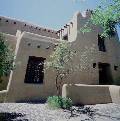
Pueblo Revival (1912 – Present)
Because they are built with adobe, Pueblo homes are sometimes called Adobes. Modern Pueblos are inspired by homes used by Native Americans since ancient times.
History:
Since ancient times, Pueblo Indians built large, multi-family houses, which the Spanish called pueblos (villages). In the 17th and 18th centuries, the Spanish made their own Pueblo homes, but they adapted the style. They formed the adobe into sun-dried building blocks. After stacking the blocks, the Spaniards covered them with protective layers of mud.
Pueblo Revival houses became popular in the early 1900s, mainly in California and the southwestern United States. During the 1920s, aviation pioneer Glenn Curtiss and his partner James Bright introduced their own version of Pueblo Revival architecture to Florida. In the region that is now Miami Springs, Curtiss and Bright built an entire development of thick-walled buildings made of wood frame or concrete block.
Modern day Pueblo homes are often made with concrete blocks or other materials covered with adobe, stucco, plaster, or mortar.
Features:
Massive, round-edged walls made with adobe
Flat roof with no overhang
Stepped levels
Rounded parapet
Spouts in the parapet to direct rainwater
Vigas (heavy timbers) extending through walls to support the roof
Latillas (poles) placed above vigas in angled pattern
Deep window and door openings
Simple windows
Beehive corner fireplace
Bancos (benches) that protrude from walls
Nichos (niches) carved out of wall for display of religious icons
Brick, wood, or flagstone floors
Due to Spanish influence, Pueblo Revival homes may also have these features:
Porches held up with zapatas (posts)
Enclosed patios
Heavy wooden doors
Elaborate corbels
Variations of the Pueblo Revival style:
Pueblo Deco. Combining Pueblo Revival with Art Deco architecture.
Santa Fe Style. This type of Pueblo became the standard in New Mexico.
Contemporary Pueblo. Stripped down, unornamented Pueblos without posts, beams, or vigas.
Territorial Pueblo. Corners are square instead of rounded. Windows are framed with straight wooden moldings.
Next: French Eclectic